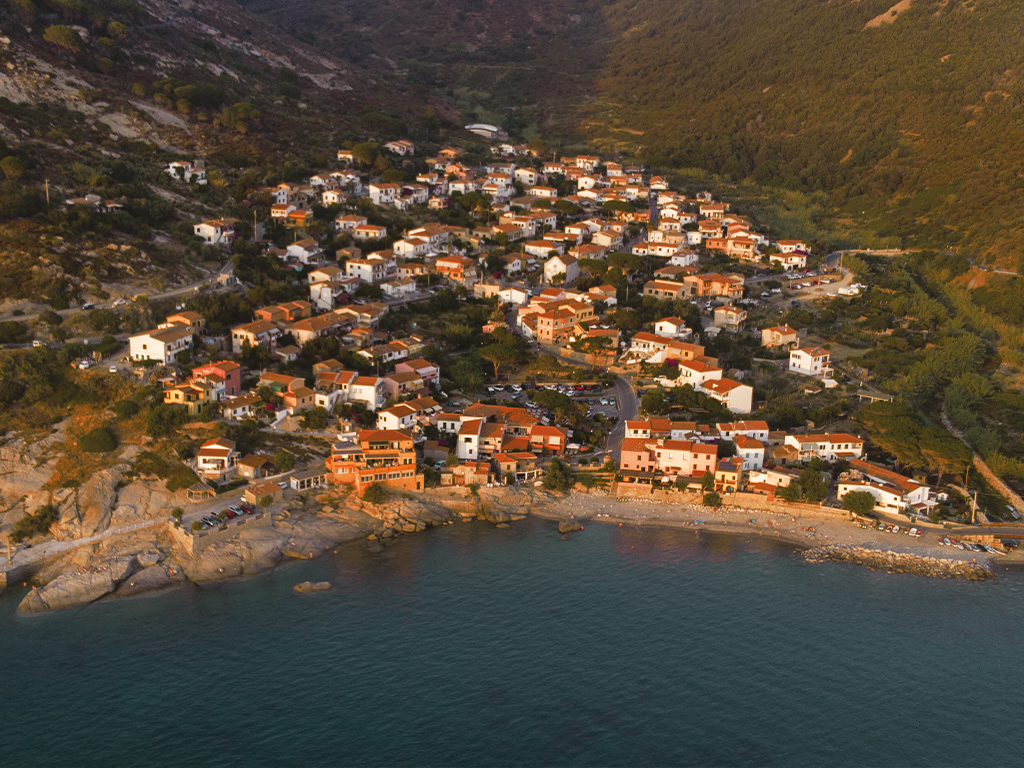Nel primo dopoguerra gli scioperi e la disoccupazione indussero molti elbani a emigrare. Giuseppe Sardi, di nascita marcianese, sposato con Edvige Specos di Rio nell’Elba, andò a New York, ritornando solo all’inizio degli Anni Cinquanta. Aveva fatto fortuna, creando un ristorante proprio nel centro della città. La moglie, rimasta con i sette figli a Rio, andava a passare l’estate a Pomonte nella casa di proprietà, la vecchia locanda sul mare. Chi incontrava il gruppo chiedeva a volte se fosse una scolaresca accompagnata dalla maestra!
Questo ricordo di famiglia faceva sorridere Sebastiana Sardi di ottantasette anni nel raccontare quegli eventi dell’infanzia come la vacanza a Pomonte, un’isola nell’Isola, raggiungibile con sicurezza solo via mare, mentre riviveva l’atmosfera sospesa nel tempo sulle piccole case assolate. La coltivazione della vite su per i terrazzamenti del Monte Capanne, e l’estrazione del granito, erano la risorsa del luogo, mentre vicino alle case, fra le pietre, si curavano i minuscoli orti. Alla base dell’alimentazione c’erano cipolle e patate, custodite nelle abitazioni fin sotto i letti, per durare tutto l’anno.
Le case, chiamate ‘magazzini’, avevano un palmento per la lavorazione dell’uva che, dopo la vendemmia, veniva usato come soppalco per dormire. Ognuna aveva la stalletta per l’asino o il mulo, munita di una finestrella da cui l’animale sporgeva fuori la testa, offrendo uno spettacolo curioso. Le donne, il volto bruciato dal sole, lavoravano anche nei campi. Ma Pomonte non era costituito da povera gente, erano tutti proprietari delle case e delle terre che lavoravano; e di abitazioni anche a Marciana.
Anche qui, come altrove, i più benestanti erano commercianti, che esportavano vino in Corsica e in Liguria. Un’altra risorsa di base erano le castagne. I marroni si mangiavano, mentre le più piccole, tenute sui tetti dei pollai a seccare, erano poi macinate nei mulini della valle di Marciana. La farinata costituiva un primo piatto. Le sere d’inverno, a veglia vicino al fuoco, si sgranocchiavano le castagne arrostite. Nei pomeriggi d’estate le ragazze, di ritorno dalle vigne, si ritrovavano all’ombra delle case, dalla parte del monte, perché non c’erano alberi: e ricamavano il corredo. Le donne andavano sul ‘luviale’ a lavare i panni sulle ‘cote’, le grandi pietre di granito. A Pomonte il pane veniva cotto una volta al mese. I lunghi filoni erano poi tagliati a fette, che si tostavano nel forno e riponevano in sacchi di tela bianca. Erano chiamate ‘micchette’. Per merenda i bambini, per venti centesimi, si facevano riempire una grande tazza di latte di capra, e con golosità vi immergevano la micchetta.
Come un gioco si procacciavano il cibo, uccellini con le tagliole, granchi e granite sugli scogli all’imbrunire. Una volta alla settimana passava la nave passeggeri, Conte Rosso o Biancamano, che girava intorno all’Isola, da Rio Marina a Marina di Campo. Una barca partiva dalla prima caletta e portava i passeggeri. La via marittima era quella più breve.
In the years just after the war, strikes and unemployment led many Elbans to emigrate. Giuseppe Sardi, born in Marciana and married to Edvige Specos from Rio nell’Elba, went to New York to return only in the early fifties. He had made his fortune by creating a restaurant right in the centre of the city. His wife, who had remained in Rio with their seven children, went to Pomonte to spend the summer. She went by sea, the safest and fastest route at that time. Those who met them, would sometimes ask if it was a school outing with their teacher! Pomonte was an island within an island.
The vineyards cultivated on the terraces of Monte Capanne and the quarrying of granite were the main resources of the area. Near the cottages, in among the rocks, everyone had a tiny vegetable patch. Their staple diet was onions and potatoes, stored away inside the house, even under the bed, to last all the year round. Their little cottages, or storehouses, had a stone-built wine vat for processing the grapes. When the harvest was over, it was useful as a support for a bed. Every storehouse had a little cowshed for the donkey or the mule, with a tiny window where the animal could poke its head out. The people of Pomonte were not poor, they all owned their cottages and the land that they tilled and would have a home also in Marciana.
Here, as elsewhere, the wealthiest were the traders who exported wine to Corsica and to Liguria.
Another staple food was chestnuts. They were good to eat and the smaller ones, left to dry on the roofs of the chicken coops, were then ground to make into flour. This flour was then used to make tasty dishes. On winter evenings, they would enjoy roast chestnuts round an open fire. On summer afternoons, after working in the vineyards, as there were no trees, the girls would meet up on the shady side of the house facing the mountain and embroider their trousseau. The women went to wash their clothes at the nearby stream, kneeling on the granite boulders. In Pomonte, the bread was baked once a month.
The long loaves were sliced and then toasted in the oven and saved in white woven sacks. The slices were called “micchette”. Food was procured as if it were a game, birds caught in traps, crabs and sea-snails found on the rocks at dusk.

